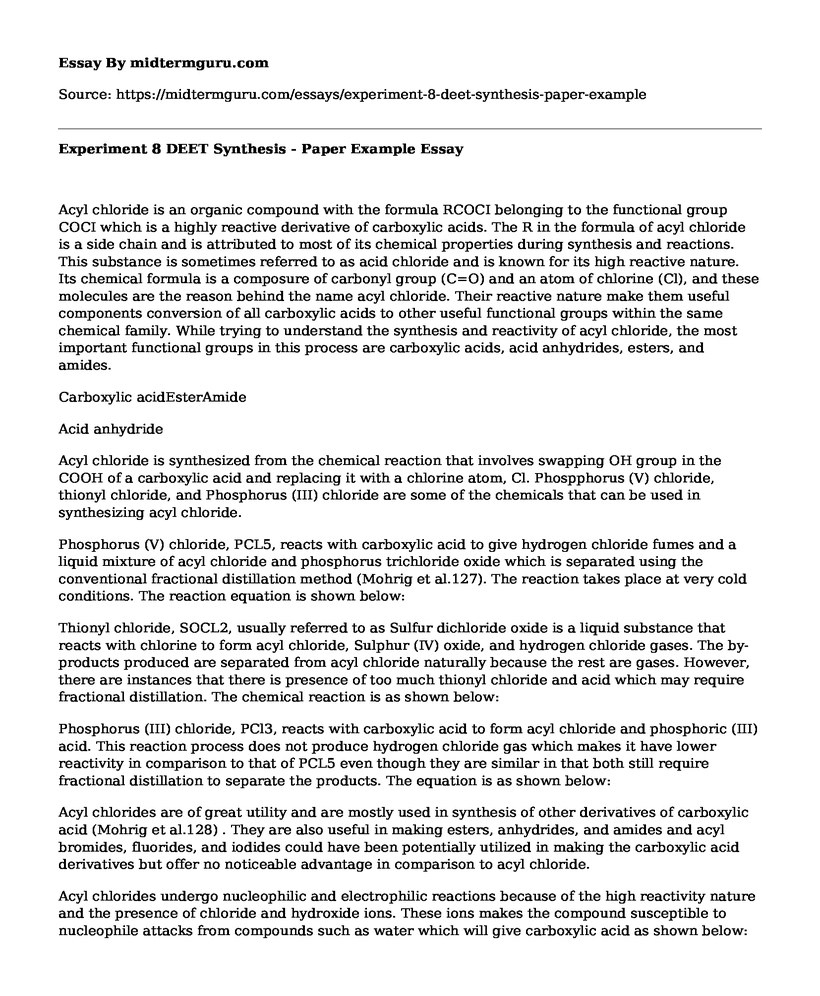Acyl chloride is an organic compound with the formula RCOCI belonging to the functional group COCI which is a highly reactive derivative of carboxylic acids. The R in the formula of acyl chloride is a side chain and is attributed to most of its chemical properties during synthesis and reactions. This substance is sometimes referred to as acid chloride and is known for its high reactive nature. Its chemical formula is a composure of carbonyl group (C=O) and an atom of chlorine (Cl), and these molecules are the reason behind the name acyl chloride. Their reactive nature make them useful components conversion of all carboxylic acids to other useful functional groups within the same chemical family. While trying to understand the synthesis and reactivity of acyl chloride, the most important functional groups in this process are carboxylic acids, acid anhydrides, esters, and amides.
Carboxylic acidEsterAmide
Acid anhydride
Acyl chloride is synthesized from the chemical reaction that involves swapping OH group in the COOH of a carboxylic acid and replacing it with a chlorine atom, Cl. Phospphorus (V) chloride, thionyl chloride, and Phosphorus (III) chloride are some of the chemicals that can be used in synthesizing acyl chloride.
Phosphorus (V) chloride, PCL5, reacts with carboxylic acid to give hydrogen chloride fumes and a liquid mixture of acyl chloride and phosphorus trichloride oxide which is separated using the conventional fractional distillation method (Mohrig et al.127). The reaction takes place at very cold conditions. The reaction equation is shown below:
Thionyl chloride, SOCL2, usually referred to as Sulfur dichloride oxide is a liquid substance that reacts with chlorine to form acyl chloride, Sulphur (IV) oxide, and hydrogen chloride gases. The by-products produced are separated from acyl chloride naturally because the rest are gases. However, there are instances that there is presence of too much thionyl chloride and acid which may require fractional distillation. The chemical reaction is as shown below:
Phosphorus (III) chloride, PCl3, reacts with carboxylic acid to form acyl chloride and phosphoric (III) acid. This reaction process does not produce hydrogen chloride gas which makes it have lower reactivity in comparison to that of PCL5 even though they are similar in that both still require fractional distillation to separate the products. The equation is as shown below:
Acyl chlorides are of great utility and are mostly used in synthesis of other derivatives of carboxylic acid (Mohrig et al.128) . They are also useful in making esters, anhydrides, and amides and acyl bromides, fluorides, and iodides could have been potentially utilized in making the carboxylic acid derivatives but offer no noticeable advantage in comparison to acyl chloride.
Acyl chlorides undergo nucleophilic and electrophilic reactions because of the high reactivity nature and the presence of chloride and hydroxide ions. These ions makes the compound susceptible to nucleophile attacks from compounds such as water which will give carboxylic acid as shown below:
Nucleophilic reactions involve reaction with salts of carboxylic acid, amines, or alcohol to form such compounds as anhydrides, amides and esters respectively. Acyl chlorides are known to be reduced by strong hydride ion donors such as lithium hydrides. Electrophilic reactions in the presence of a catalyst result to aryl ketones which are formed by dissociation and regeneration of chloride atoms.
Acyl chloride is used in preparation of N, N-diethyl-m-toluamide (DEET) through the combination of both nucleophilic and electrophilic reactions as shown in the equation below:
In the above case, the acid chloride of the m-toluic acid will serve as the electrophile and the diethylamine will serve as the nucleophile and the base. The equation will take the following path:
The product, N, N-diethyl-m-toluamide (DEET), is made from acyl chloride which is usually simplified by the use of m-toluoyl which is readily available. The final product from the above reactive schemes is, therefore, formed as illustrated in the following equations:
References
Knoess, Peter H., and Edward G. Neeland. "A Modified Synthesis of the Insect Repellent DEET." Journal of Chemical Education 75.10 (2008): 1267. Web. 29 Apr. 2017.
Mohrig, Jerry R., Christina Noring. Hammond, and Paul F. Schatz. Techniques in organic chemistry: miniscale, standard taper microscale, and Williamson microscale. New York: W.H. Freeman, 2010. Print.
Cite this page
Experiment 8 DEET Synthesis - Paper Example. (2021, Jun 25). Retrieved from https://midtermguru.com/essays/experiment-8-deet-synthesis-paper-example
If you are the original author of this essay and no longer wish to have it published on the midtermguru.com website, please click below to request its removal:
- Problems and Solutions on Engineering Mathematics - Paper Example
- The Domains Identified for Tentative Selected Focused Observations - Research Paper
- Report on Math
- Japanese Food: Geography and History Matter! - Essay Sample
- Space Exploration: A Journey Across the Moon - Research Paper
- Inequalities: Understanding the Language of Math in Everyday Life - Essay Sample
- Cultural Practices of Ethnic Groups: Global Differences & Civilization - Research Paper







